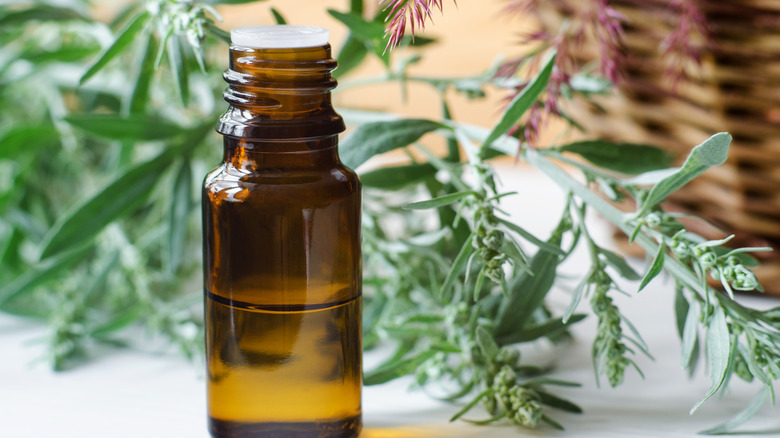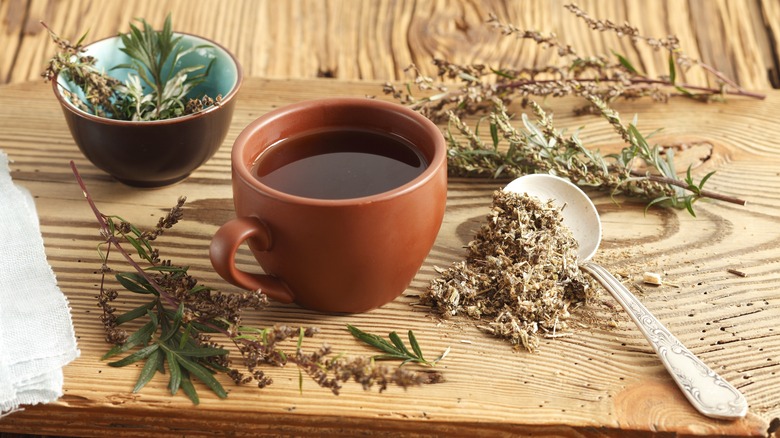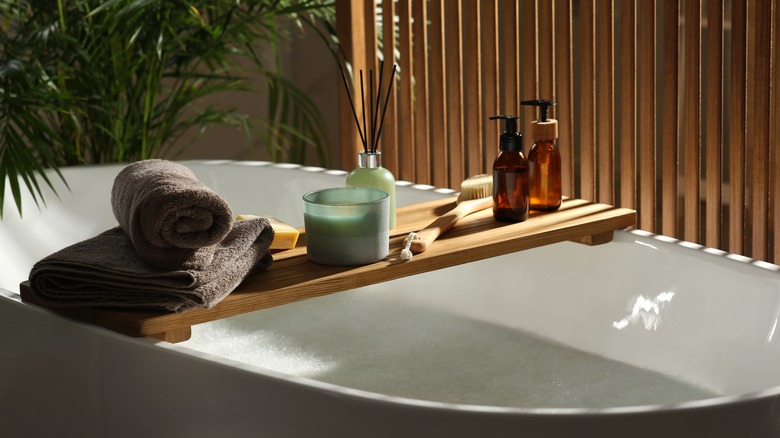What Is A Mugwort Bath, And How Is It Helpful?
Mugwort may seem like your run-of-the-mill weed, but before pulling it out of your garden, you might want to know some of its legendary health and wellness benefits. Mugwort is indigenous to Europe and Asia and has been used for thousands of years to cure maladies and promote immunity, per Eat Weeds. The plant goes by many names — its scientific name, Artemisia vulgaris, chrysanthemum weed, mother herb, and wormwood, according to the National Center for Complementary and Integrative Health, and it is used in tinctures and teas to regulate menstrual cycles, digestion, and calm the nerves.
Like many natural remedies, there is less than substantial research dedicated to mugwort's effectiveness. But there's growing interest in homeopathic formulas and alternative treatments like aromatherapy and essential oil combinations for peaceful relaxation. If you're already a fan of using natural products, some version of mugwort may be just what you've been missing from your self-care routine.
The benefits and potential risks of a mugwort bath
Mugwort tea is also called lucid dream tea, and the plant is regularly connected to helping with sleep and reducing stress, per VeryWell Health. The outlet provides a recipe that calls for 1.5 teaspoons of the dried plant, a cup of water, and 10 minutes to steep. One study via ScienceDirect demonstrates that mugwort's fatty acids have major nutritional merits and its immature stems can even be used as salad greens.
The flower is ready to be made into essential oil when it is in bloom. Making essential oils from the plant takes advantage of its chemical compounds, camphor, pinene, and cineole, which provide the plant with antioxidant, antibacterial, and antifungal properties, according to VeryWell Health, though there are studies warning against the danger of related allergies when exposed to a new herb.
Per research from the National Library of Medicine, considering the umbelliferous family of spices, allergies to mugwort were connected to potential reactions to celery, carrots, parsley, fennel, and green pepper. This is sometimes known as Celery-Mugwort-Spice Syndrome, which occurs when proteins in a new herb are shaped like those in a person's pre-existing allergen, per Allergy Resources. Once you've determined you don't have a mugwort sensitivity, you can take advantage of its dozens of possible benefits.
The traditional bath can help your body recover
According to research in the National Library of Medicine, mugwort is used in Chinese medicine for moxibustion, a practice dating back 2500 years in which the leaves are rolled into sticks and burned for the smoke's healing properties. When the smoke is exposed to acupuncture points, it releases energy, per Healthline.
A 2011 study on heart rate and variability measured this smoke's potential effects on the automatic immune system, finding that it produced a decreased heart rate and a smaller range of rates, demonstrating a depressant, or calming effect. The researchers also connected the plant to immune benefits.
Separate from its use during acupuncture, mugwort has a reputation for muscle relaxation and helping with blood circulation and soreness. The founders of Riley House use their knowledge of Korean cultural traditions to help others benefit from mugwort, or "Yak-Ssuk" in Korean. A bag of their Female Wellness bath soak can go directly into a bath or be brewed in a pot and added to your bath water.
Care Acupuncture also produces a mugwort soak, and recommends using the bath salts twice per week, potentially combined with your favorite essential oils or in a bubble bath. Locust Light Farms suggests steeping the dried herb in hot water for up to an hour before straining and adding it to your bath. Other standout mugwort products include foot baths, shampoos, and soaps (via Yuan Skincare & Soap).


